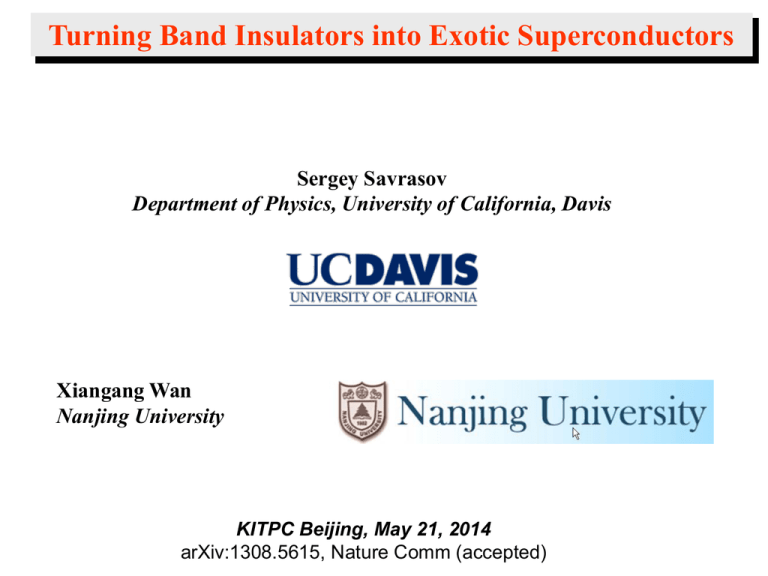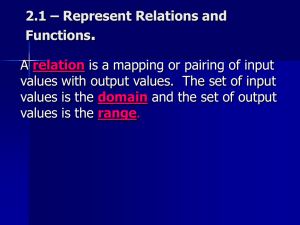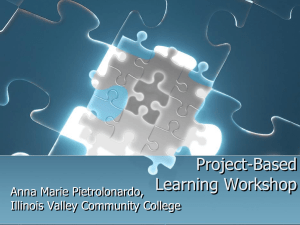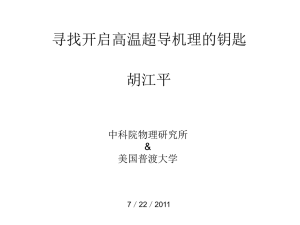Superconductivity in Cu x Bi 2 Se 3
advertisement

Turning Band Insulators into Exotic Superconductors Sergey Savrasov Department of Physics, University of California, Davis Xiangang Wan Nanjing University KITPC Beijing, May 21, 2014 arXiv:1308.5615, Nature Comm (accepted) Contents Electron-Phonon Interaction and Unconventional Pairing Superconductivity in CuxBi2Se3 Calculations of phonons and electron-phonon interactions in CuxBi2Se3 Effects of Coulomb interaction: m* and spin fluctuations Conclusion Introduction Recent developments in the theories of TIs have been extended to superconductors described by Bogoluibov-de Genne Hamiltonians: Such excited phenomena as topologically protected surface states (Majorana modes) have been discussed (Schynder et al. PRB2008, Kitaev, arXiv 2009, Qi et al., PRL 2009). These have potential uses in topologically protected quantum computation Need for unconventional (non-s-wave like) symmetry of superconducting gap that is now of odd-parity which would realize a topological superconductor. Not many odd-parity superconductors exist in Nature! One notable example is SrRu2O4 where not phonons but ferromagnetic spin fluctuations mediate superconductivity. Why electron-phonon superconductors are all s-wave like? Are there examples in nature whether electron-phonon coupling can generate a pairing state with l>0 angular momentum? BCS with General Pairing Symmetry BCS gap equation for Tc where W(kk') is the pairing interaction (always attractive, negative in electron-phonon theory, but can be sign changing in other theories) To solve it, assume the existence of orthonormalized polynomials at a given energy surface (such, e.g., as spherical harmonics in case of a sphere) Choice of Fermi surface polynomials Elegant way has been proposed by Allen: Fermi surface harmonics Tight-binding harmonics for cubic/hexagonal lattices are frequently used Expanding superconducting energy gap and pairing interaction The gap equation becomes In original BCS model pairing occurs for the electrons within a thin layer near Ef This reduces the gap equation to (integral is extended over Debye frequency range) Assuming crystal symmetry makes Wab=Wadab and evaluating the integral gives where the average electron-phonon coupling in a given a channel is given by the Fermi surface average of the electron-phonon coupling Finally, the superconducting state with largest la will be realized. If mass renormalizations and Coulomb interaction effects are taken into account, the Tc is determined by where the effective coupling constant is weakened by m* and renormalized Due to electronic mass enhancement like in specific heat renormalization because Fermi surface averaging of the interaction includes bare DOS and e(k) The electron-phonon matrix elements W(kk') can be found from first principles electronic structure calculations using density functional linear response method (SS, PRL 1992) Density Functional Linear Response Tremendous progress in ab initio modeling lattice dynamics & electron-phonon interactions using Density Functional Theory Superconductivity & Transport in Metals Recent Superconductors: MgB2, LiBC, etc Superconductivity in MgB2 was recently studied using density functional linear response (after O.K. Andersen et.al. PRB 64, 020501 (R) 2002) Doped LiBC is predicted to be a superconductor with Tc~20 K (in collaboration with An, Rosner Pickett, PRB 66, 220602(R) 2002) Why electron-phonon superconductors are all s-wave like? The electron-phonon matrix elements appeared in the expression for l are fairly k-independent! In the extreme case we obtain: that is only s-wave lambda is larger than zero, all other pairing channels have zero coupling. Are more exotic pairings possible due to strong anisotropy of electron-phonon interaction? Consider another extreme: an EPI singular at some wavevector q0 We obtain where the overlap matrix between two polynomials shows up It would be less than unity for non-zero angular momentum index a unless We obtain that l’s become degenerate, , for all(!) pairing channels if electron-phonon coupling gets singular at long wavelenghts only! However, even in this extreme scenario, for the l>0 state to win, additional effects such as Coulomb interaction m*, need to be taken into account. That is why, practically, in any intermediate case, s-wave symmetry always wins, since it always makes largest electron-phonon l. To find unconventional pairing state we have to look for materials with singular EPI and this should occur at small wavevectors (longwavelength limit!) Too narrow window of opportunity? We predict by first principle calculation that is the case of doped topological insulator Bi2Se3. Contents Electron-Phonon Interaction and Unconventional Pairing Superconductivity in CuxBi2Se3 Calculations of phonons and electron-phonon interactions in CuxBi2Se3 Effects of Coulomb interaction: m* and spin fluctuations Conclusion Superconductivity in Doped Topological Insulators Criterion by Fu and Berg (PRL 2010): a topological superconductor has odd-parity pairing symmetry and its Fermi surface encloses an odd number of time reversal invariant momenta (that are G,X,L points of cubic BZ lattices) Implications for topological insulators: doped topological insulator may realize a topological superconductor Theory by Fu and Berg (PRL 2010): doping Bi2Se3 with electrons may realize oddparity topological superconductor with conventional electron-phonon couplings: Doping TRIM point Superconductivity in CuxBi2Se3 Hor et al, PRL 104, 057001 (2010) Cu Hor et al, PRL 104, 057001 (2010) Tc up to 3.8K Symmetry of Pairing State Point-contact spectroscopy: odd-parity pairing in CuxBi2Se3 (Sasaki et.al, PRL 2011) via observed zero-bias conductance Scanning-tunneling spectroscopy: fully gapped state in CuxBi2Se3 (Levy et.al, arXiv 2012) Contents Electron-Phonon Interaction and Unconventional Pairing Superconductivity in CuxBi2Se3 Calculations of phonons and electron-phonon interactions in CuxBi2Se3 Effects of Coulomb interaction: m* and spin fluctuations Conclusion Phonon Spectrum for Bi2Se3 Calculated phonon spectrum with density functional linear response approach (SS, PRL 1992) Local Density Approximation, effects of spin orbit coupling and the basis of linear muffintin orbitals is utilized. Calculated Phonon Density of States for Bi2Se3 Bi modes Te modes INS Data from Rauh et.al, J Phys C. 1981 Phonons at G point for Bi2Se3 LDA+SO calculations, in cm-1 Grid 10-10-10 8-8-8 6-6-6 2xEg 45 44 44 1xAg 2xEu 74 90 48 91 48 91 2xEg 124 125 125 2xEu 136 136 136 1xAu 152 136 136 Exp (Richter 77) --72 65?? Exp (PRB84,195118) 38.9 73.3 -- 131 132 134 --- LDA(PRB83,094301) 41 GGA(PRB83,094301) 38 LDA(APL100,082109) 41 137 124 138 130 127 131 75 64 77 80 65 80 1xAu 150 153 154 1xAg 160 164 164 --- ----- 174 175 137 137 138 161 155 161 171 166 175 Large Electron-Phonon Interaction in CuxBi2Se3 pz-like px,y-like S-wave shows largest coupling. P-wave is also very large! Calculated phonon linewidths in doped Bi2Se3 Electron-phonon coupling is enormous at q ~(0,0,0.04)2p/c Energy Bands in CuxBi2Se3 Doping Fermi Surfaces of CuxBi2Se3 Doping 0.16 el. Doping 0.07 el. Doping 0.26 el. Nesting Function Doping 0.16 el. Basal area is rhombus Shows a strong ridge-like structure along GZ line at small q’s due to quasi 2D features of the Fermi surface. Calculated electron-phonon matrix elements Define average electron-phonon matrix element (squared) as follows This eliminates all nesting-like features of Still <W(q)> shows almost singular behavior for q0~(0,0,0.04)2p/c Calculated deformation potentials at long wavelengths Large electron-phonon effects are found due to splitting of two-fold spin-orbit degenerate band by lattice distortions breaking inversion symmetry. The role of spin-orbit coupling is unusual! Implications of singular EPI for BCS Gap Equation For almost singular electron-phonon interaction that we calculate with q0~(0,0,0.04)2p/c, (W0 is attractive, negative) the BCS gap equation yields D(k)~D(k+q0) compatible with both s-wave and p-wave symmetries! Fermi surface of doped Bi2Se3 colored by the gap D(k) of A2u (pz-like) symmetry. +0.5 -0.5 Contents Electron-Phonon Interaction and Unconventional Pairing Superconductivity in CuxBi2Se3 Calculations of phonons and electron-phonon interactions in CuxBi2Se3 Effects of Coulomb interaction: m* and spin fluctuations Conclusion Can m* suppress s-wave? The Tc includes Coulomb pseudopotential m* where ml is the Fermi surface average of some screened Coulomb interaction Assuming Hubbard like on-site Coulomb repulsion m* will affect s-wave pairing only Alexandrov (PRB 2008) studied a model with Debye screened Coulomb interaction and arrived to similar conclusions that Estimates with m* For doped Bi2Se3 we obtain the estimate D ~ 100K e F ~ 2000 5000 K and ms* 0.1 For doping by 0.16 electrons we get the estimates S-wave lsEPI 0.45 ms* 0.1 P-wave lAEPI 0.39 ml*s ~ 0 2u Effective coupling l-m* for p-wave pairing channel wins! Estimates for spin fluctuations Spin fluctuations suppress s-wave electron-phonon coupling and can induce unconventional (e.g. d-wave) pairing lleff llEPI ml* llSF SF 1 lsEPI l h s h Coupling Constants due to Spin Fluctuations Evaluate coupling constants in various channels with the effective interaction for singlet pairing and for triplet pairing Spin fluctuational mass renormalizations: Stoner Instability in doped Bi2Se3 Stoner criterion provides some estimates for the upper bounds of U Doping (el) N(0), st/eV Critical U (eV) 0.1 0.8 1.2 0.2 1.5 0.7 0.3 1.8 0.54 FLEX Coupling Constants Resulting Coupling Constants For doping by 0.16 electrons we get the estimates ( negative is repulsion) S-wave P-wave l 0.45 m 0.1 l m l l EPI s * s SF s 0.05 lsTotal 0.30 EPI A2 u * l s 0.39 ~0 0.02 SF A2 u (positive, attractive!) U 0.5eV W 1.2eV lATotal 0.41 2u Effective coupling lEPI-m*+lSF (note sign convention!) for p-wave pairing of A2u symmetry may be largest one! l eff A2 u 0.41 1/ l Aeff 2u 0.27, Tc 1.14D e 3K 1 0.45 0.05 Similar consequences are seen at other doping levels where the difference between electron-phonon ls and lp is between 0.1 and 0.2. Conclusion Large electron-phonon coupling is found for CuxBi2Se3 Not only s-wave but also p-wave pairing is found to be large due to strong anisotropy and quasi-2D Fermi surfaces. ls~lp Coulomb interaction and spin fluctuations will reduce ls and make lp>lp therefore unconventional superconductivity may indeed be realized here. Discussed effects have nothing to do with topological aspect of the problem, may be found in other doped band insulators.






